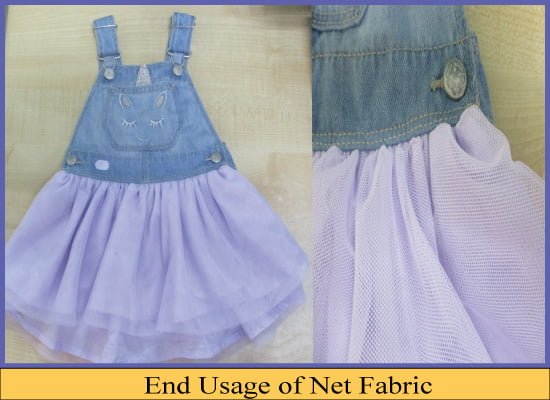What is Net Fabric | Types and End Uses of Net Fabric
Last updated on August 10th, 2023 at 12:52 am
Definition of Net Fabric
Net or netting is an open mesh form of fabric construction that is held together by knots or fused thermoplastic yarns at each point where the yarn cross one another. There are several types of mesh; they are square, hexagonal, and octagonal. The range of mesh sizes is from coarse and opens to find and share. Netting may be made of any kind of fibre and may be given a soft or stiff sizing. Net fabrics are relatively fragile and require care in handling and cleaning. Torn net fabrics cannot be satisfactorily mended because the repair would be apparent. If the sizing is water-soluble, the fabric should be dry-cleaned.

Early nets were made by hand-knotting yarns at each point of intersection to produce a specific geometric pattern. Prior to 1809, nets were made by hand, but in that year a new machine produced knotted nets so like hand-knotted fabrics that few people could distinguish between them. The comparatively large mesh of knotted nets does not slip, spread or distort during use. Knotted nets are used for hammocks and fishing nets.
You may also like: An Overview of Different Types of Lightweight Fabric
In recent years most light nets have been constructed on either Tricot or Raschel knitting machines, so the yarns are only interloped and not knotted. These knitted nets lack the stability of those constructed by knotting. Their primary use is in apparel, although some are used as decorative window hangings.
Types of Net Fabric
There is a variety of netting; some are produced under specific trademarks. Among the best-known standard fabrics are noted here. These nets are classified as bobbinet, fishnet, filet, maline or tulle.
- Bobbinet: It is a hexagonal mesh that may be very thin and transparent (bridal illusion) or fairly coarse and opaque (casement cloth), depending on the yarn count of the material used to produce it. Most bobbinet sold in the United States is produced in England and France.
- Tulle: It is a fine, stiff hexagonal net made from silk or nylon yarns. It is very similar to a bobbinet but lighter in weight than a bridal illusion; some references do not separate bobbinet and tulle. It is generally used for trimming or over draping of dress goods.
- Fishnet: It is a coarse open-mesh construction created by knotting the mesh in a manner similar to a fisherman’s knot.
- Filet net: It is made with a square mesh, and maline net, used in millinery, is a fine, very thin, diaphanous; open a diamond shape with hexagonal holes.
Uses of Net Fabric
- Netting is one of the key components of fishing in mass quantities. This textile is used because of its sturdy yet flexible origin, which can carry weight yet, still be lightweight and compactable. Fishermen use netting when trawling, because it is sturdy enough to carry large amounts of weight as fish are trapped, pulled, then lifted out of water.
- Net is also used in medical practices to provide fabric insulation and wrapping under an industry-standard sling. In medical practice, netting provides cushion and protection, when used in layers, but still allows the skin to breathe under the fabric.
- Depending on what the netting is being used for, a different wax or plastic coating can be applied in order to cover the filaments that use up the yarn. Filaments can be made from synthetic or natural fibres, but that is all up to the manufacturer when deciphering what the future of the textile entails. When netting is going to be exposed to water or heat often, manufacturers consider that and apply what best fits that textile.
- Net is commonly used in camping tents. Air can easily pass through the holes, which allow breathability that doesn’t trap bacteria, and remain impermeable to pests and insects.
- Netting is often used for luggage bags to create transparent, breathable compartments that allow people to store items.




Could you plz tell me about non woven fabric?
I liked your blog. It is very helpful and also provide relevant information. If you want more fabrics online then here is the store that deals in fabrics
Hmm, it seems like your site ate my first comment (it was extremely long) so I guess I’ll just sum it up what I had written and say, I’m thoroughly enjoying your blog. I as well am an aspiring blog writer, but I’m still new to the whole thing. Do you have any recommendations for newbie blog writers? I’d appreciate it.
You’ve been great to me. Thank you!
Your blog would increase in ranking if you post more often.“*;: